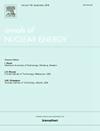Thermal-hydraulics performance and stability two-phase flow using Al2O3 nanofluids in an open natural circulation loop
IF 1.9
3区 工程技术
Q1 NUCLEAR SCIENCE & TECHNOLOGY
引用次数: 0
Abstract
The thermal-hydraulics performance and stability flow using Al2O3 nanofluids in an open natural circulation loop has been investigated. Experiments were conducted with a gradual increase in heating power from 880 up to 1350 . The working fluid used Al2O3 with variations of 0.025 , 0.05 , and 0.1 . The two-phase flow pattern was observed using 1 fps range macro photos. PSD (power spectral density) and DWT (discrete wavelet transform) signal processing were used to analyze the thermal-hydraulics performance and flow stability that occurred during the experiments. The result shows that there are three types of oscillations were found in the observations based on heating power, intermittent oscillation with expulsion-refill-incubation stages, sinusoidal oscillation with expulsion and refill stages, and high subcooling stable flow circulation with only one continuous refill stage. PSD and DWT analysis provided solid agreement between the temperature signal and thermal-hydraulics performance and flow stability.
在开放的自然循环回路中使用Al2O3纳米流体的热工性能和稳定性
研究了Al2O3纳米流体在开放自然循环回路中的热工性能和稳定流动。实验中加热功率从880 W逐渐增加到1350 W。工作液中使用的Al2O3含量分别为0.025 wt%、0.05 wt%和0.1 wt%。采用1fps范围的微距照片观察两相流型。采用功率谱密度(PSD)和离散小波变换(DWT)信号处理对实验过程中的热工性能和流动稳定性进行分析。结果表明,基于加热功率的观测结果存在三种振荡类型,即排出-再填充-孵育阶段的间歇振荡,排出-再填充阶段的正弦振荡,以及只有一个连续再填充阶段的高过冷稳定流动循环。PSD和DWT分析在温度信号与热工性能和流动稳定性之间提供了坚实的一致性。
本文章由计算机程序翻译,如有差异,请以英文原文为准。
求助全文
约1分钟内获得全文
求助全文
来源期刊

Annals of Nuclear Energy
工程技术-核科学技术
CiteScore
4.30
自引率
21.10%
发文量
632
审稿时长
7.3 months
期刊介绍:
Annals of Nuclear Energy provides an international medium for the communication of original research, ideas and developments in all areas of the field of nuclear energy science and technology. Its scope embraces nuclear fuel reserves, fuel cycles and cost, materials, processing, system and component technology (fission only), design and optimization, direct conversion of nuclear energy sources, environmental control, reactor physics, heat transfer and fluid dynamics, structural analysis, fuel management, future developments, nuclear fuel and safety, nuclear aerosol, neutron physics, computer technology (both software and hardware), risk assessment, radioactive waste disposal and reactor thermal hydraulics. Papers submitted to Annals need to demonstrate a clear link to nuclear power generation/nuclear engineering. Papers which deal with pure nuclear physics, pure health physics, imaging, or attenuation and shielding properties of concretes and various geological materials are not within the scope of the journal. Also, papers that deal with policy or economics are not within the scope of the journal.
 求助内容:
求助内容: 应助结果提醒方式:
应助结果提醒方式:


